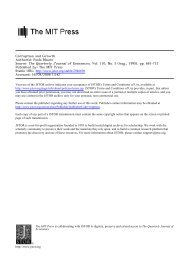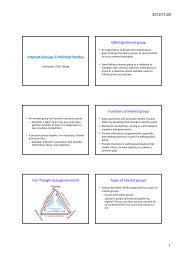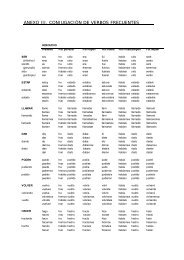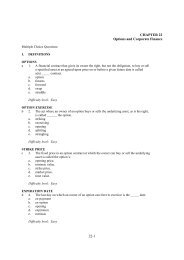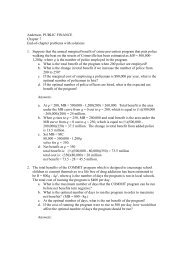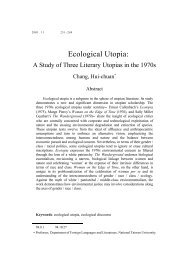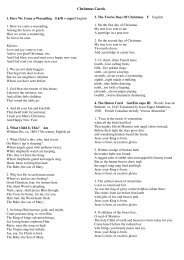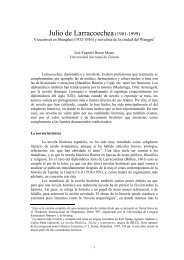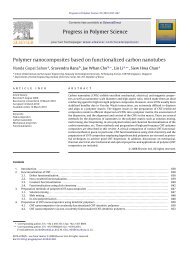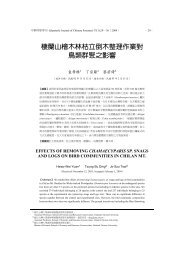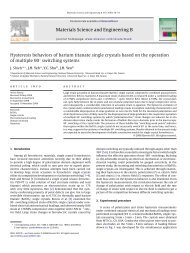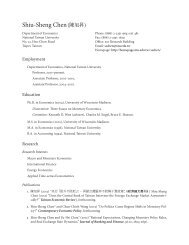Mnemonics and Bacon
Mnemonics and Bacon
Mnemonics and Bacon
You also want an ePaper? Increase the reach of your titles
YUMPU automatically turns print PDFs into web optimized ePapers that Google loves.
100<br />
臺 大 文 史 哲 學 報<br />
Since the Greek sources Rhetorica ad Herennium draws on, which per se are<br />
treatises on rhetoric, are all lost, the historical uniqueness of Rhetorica ad<br />
Herennium speaks for itself (Kennedy 123; Yates 21). This unknown author of<br />
Rhetorica ad Herennium, following Aristotle, suggests that an ideal orator possess<br />
the following elements: inventio, dispositio, elocutio, memoria, <strong>and</strong> pronuntiatio.<br />
And in mnemonics what matters the most is locus <strong>and</strong> images, <strong>and</strong> a locus is “a<br />
place easily grasped by the memory, such as a house, an intercolumnar space, a<br />
corner, an arch, or the like. Images are forms, marks or simulacra of what we wish to<br />
remember” (Yates 22). 7<br />
It should also be noted that the role of memory in rhetoric is not restricted to<br />
the fivefold scheme mentioned in the preceding paragraph. The connection between<br />
memory <strong>and</strong> rhetoric can be investigated from other angles. The author of Rhetorica<br />
ad Herennium, for example, contends that memory occupies a significant role in the<br />
tripartite definition of wisdom (prudentia). Wisdom, it states, is tantamount to<br />
“intelligence capable… by a certain judicious method, of distinguishing good <strong>and</strong><br />
bad” (III. ii; 162). A parallel idea can be found in De Inventione, where Cicero<br />
defines wisdom as the caliber to distinguish the good from the bad (II. lii; 327). And<br />
the essential elements of wisdom are memory, intelligence, <strong>and</strong> foresight; memory,<br />
suggests Cicero, is “the faculty by which the mind recalls what has happened” (II. lii;<br />
327). 8 Yates indicates that Cicero’s definition of wisdom in De Inventione serves as<br />
a significant precursor in molding what later becomes known as “the four cardinal<br />
virtues.” 9 When elaborating on the four cardinal virtues, both Albertus Magnus <strong>and</strong><br />
Thomas Aquinas adduce Cicero’s definition of prudence, <strong>and</strong>, more importantly, it is<br />
the prestige associated with the name “Cicero” that rivets medieval scholars’<br />
attention to the art of memory (Yates 20).<br />
(2). Plato, Aristotle, <strong>and</strong> Wax Tablet<br />
Rhetoric for Herennius to Cicero (Wilkins 51). Now the authorship of Rhetoric for<br />
Herennius remains an inconclusive question. For useful discussions, see Kennedy, pp.<br />
121-26, <strong>and</strong> Wilkins, pp. 51-56.<br />
7 In addition to locus <strong>and</strong> images, architecture is also closely connected with mnemonics.<br />
For the connection between architecture <strong>and</strong> mnemonics, see Mary Carruthers’ excellent<br />
treatment in The Craft of Thought: Meditation, Rhetoric, <strong>and</strong> the Making of Images,<br />
400-1200 (Cambridge: Cambridge UP, 1998), pp. 7-24.<br />
8 Whereas intelligence is the faculty “by which it [the mind] ascertains what is,” foresight<br />
is the faculty “by which it is seen that something is going to occur before it occurs” (De<br />
Inventione II, lii; 327).<br />
9 The four cardinal virtues are prudence, justice, fortitude, <strong>and</strong> temperance.



